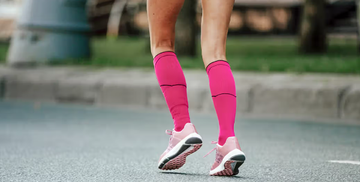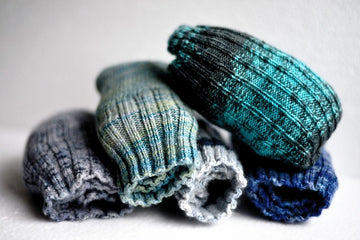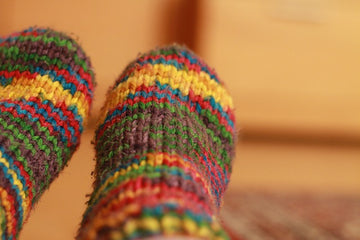
Ever felt your legs ache and swell after a long flight? You're not alone. Sitting for extended periods can restrict blood flow in your legs, leading to discomfort and potentially increasing the risk of blood clots. This is where compression socks come in. But are flight socks the same thing? This article explores the world of compression socks, focusing on how they differ from flight socks specifically designed for travelers.
What are compression socks?
Compression socks are specialized socks designed to apply gentle pressure to your legs and ankles. This pressure helps improve blood circulation in your legs, specifically by promoting blood flow from your legs back towards your heart.
Benefits of compression socks
- Improved Circulation: By squeezing your legs, compression socks help your veins pump blood more efficiently back to your heart. This can be helpful for people who suffer from poor circulation or conditions like varicose veins.
- Reduced Swelling: Compression socks can help reduce swelling in your legs and ankles, which can be caused by sitting or standing for long periods, pregnancy, or certain medical conditions.
- Pain Relief: The improved circulation and reduced swelling from compression socks can also help to relieve pain and discomfort in the legs.
- Faster Recovery: Some studies suggest that compression socks can help athletes recover faster after exercise by reducing muscle soreness and fatigue.
- Reduced Risk of Blood Clots: Sitting for long periods, such as on a long flight, can increase your risk of developing blood clots. Compression socks can help to prevent this by improving blood flow in your legs.
What are flight socks?
Flight socks, also known as compression socks for travel, are knee-high socks designed to improve circulation and comfort during long flights.
- Graduated Compression: They apply gentle pressure to your legs, strongest at the ankle and gradually looser moving up your calf. This helps squeeze blood back towards your heart, reducing pooling and the risk of blood clots (deep vein thrombosis or DVT) that can occur from prolonged sitting.
- Improved Circulation: By promoting blood flow, flight socks can help reduce swelling, aches, and tiredness in your legs during and after a long flight.
- Comfort: Some flight socks come with additional padding in areas prone to soreness during flights, enhancing overall comfort.
While primarily used for travel, flight socks can also be beneficial for people who sit or stand for extended periods throughout the day.
- Compression Level: Flight socks typically offer a milder level of compression (around 15-20 mmHg) compared to medical-grade compression socks.
- Not a cure-all: While they help reduce the risk of DVT, they are not a guaranteed prevention method. Talk to your doctor if you have any particular concerns about DVT.
- Consult a doctor: If you have any underlying medical conditions, consult your doctor before using flight socks.
Overall, flight socks are a travel essential for many people, offering improved circulation, comfort, and potentially reducing the risk of DVT during long flights.
Are Flight Socks the Same as Compression Socks
Flight socks are a type of compression socks, but not all compression socks are flight socks.
Compression socks apply graduated pressure to your legs, strongest at the ankle and gradually decreasing as it goes up. This helps improve blood circulation and reduce swelling, especially when you're sitting or standing for long periods. They come in various compression levels to address different medical conditions.
Flight socks are a specific type of compression sock designed for travelers. They typically offer a milder level of compression (around 15-20 mmHg) compared to medical-grade compression socks (20-30 mmHg or higher). Their main purpose is to help prevent blood clots from forming during long flights by promoting blood flow in the legs.
In short, flight socks are essentially a subcategory of compression socks geared towards travelers. If you're looking for socks to improve circulation during travel, flight socks are a good option. But if you need a higher level of compression for a medical condition, you'll need to consult with a doctor to get properly fitted for medical-grade compression socks.
What is the difference between compression socks and travel socks?
There's actually very little difference between compression socks and travel socks (also known as flight socks). Flight socks are simply a type of compression sock specifically designed for travel purposes.
- Compression Socks: These socks apply graduated pressure, strongest at the ankle and looser moving up the leg. This helps improve circulation and blood flow. They come in various compression levels for different needs, from mild (8-15 mmHg) for travel to firm or extra firm for medical conditions.
- Travel Socks (Flight Socks): These are compression socks designed for wearing on flights. They typically offer a mild level of compression (14-17 mmHg) to prevent blood clots (DVT) and leg swelling during long journeys.
So, if you're looking for socks for travel purposes, flight socks (a type of compression sock) are a good option with their mild compression level. But compression socks offer a wider range of pressures for various needs, including travel.
Are flight socks as good as compression socks?
Flight socks can be just as good as compression socks for travel purposes, with a caveat: it depends on the compression level you need.
- Compression Level: This is the key difference. Flight socks typically offer a mild compression level (14-17 mmHg) designed to prevent blood clots and swelling during flights.
- Medical Needs: Regular compression socks come in a wider range of pressures, from mild (similar to flight socks) all the way to extra firm (30-40 mmHg). These higher compression levels are for medical conditions that require improved circulation or reduced swelling beyond what flight socks offer.
So, for travel:
Flight socks are a good option: Their mild compression is sufficient for most travelers to prevent DVT and swelling.
Regular compression socks can also work: If you find flight socks don't provide enough pressure, you can choose regular compression socks with a similar mild level (around 15 mmHg).
Material quality is important for both: Regardless of whether you choose flight socks or regular compression socks, make sure they are made from high-quality materials that will retain their shape and compression level over time.
Are flight socks the same as hospital socks?
Flight socks and hospital socks serve different purposes and have distinct features.
Flight Socks:
Designed for travelers, particularly for long flights.
Offer mild to moderate graduated compression (typically 14-17 mmHg) to improve circulation and prevent blood clots (DVT) and swelling in your legs during travel.
Meant to be worn while you're seated for extended periods.
Hospital Socks:
Medically prescribed for patients who are bedridden or have mobility limitations.
May offer higher compression levels than flight socks (depending on the medical condition).
Designed to promote blood flow and prevent blood clots in immobile patients whose legs are often at the same level as their heart.
May be uncomfortable for walking or extended sitting.
Key Differences:
Compression Level: Flight socks - mild to moderate, Hospital socks - vary depending on medical need.
Purpose: Flight socks - prevent DVT during travel, Hospital socks - promote blood flow in immobile patients.
Mobility: Flight socks - meant for sitting/standing, Hospital socks - for bedridden or patients with limited mobility.
What's the difference between socks and compression socks?
Compression socks are definitely different from your regular everyday socks.
- Pressure: Regular socks are all about comfort and fit snugly around your feet. Compression socks, on the other hand, apply graduated pressure. This means they're tightest at the ankle and gradually loosen as they move up your leg. This pressure helps squeeze your legs gently, aiding blood flow back to the heart.
- Purpose: Regular socks are for everyday wear, protecting your feet and keeping them comfortable. Compression socks have a specific health purpose. They're often recommended for people who suffer from circulation problems, swelling, or varicose veins. Athletes may also wear them to improve performance and recovery.
- Material: Compression socks are typically made from specialized fabrics that help maintain the graduated pressure. Regular socks come in a wider variety of materials, from cotton to wool, depending on warmth and moisture-wicking needs.
When not to wear flight socks?
- Certain medical conditions: If you have circulatory problems in your legs (arterial insufficiency) or serious heart issues, consult a doctor before wearing flight socks. The compression can be counterproductive in these cases.
- Pregnant: While some pregnant women find flight socks helpful, it's always best to check with your doctor first.
- Sensory issues: People with diabetes or neuropathy (nerve damage) might not feel if the socks are too tight, which could lead to circulation problems.
How long should you wear compression socks when flying?
You can wear compression socks for the entirety of your flight, which can be well over 16 hours. In fact, some recommend wearing them even before you get to the airport. If you're feeling any discomfort after a few hours, it's okay to take them off for a short while and put them back on. While generally safe for long wear, it's always best to consult your doctor if you have any underlying conditions.
Should everyone wear compression socks on a long flight?
Compression socks offer benefits for many travelers, even those without specific medical conditions.
- Improved Circulation: Sitting for long periods restricts blood flow in the legs. Compression socks help blood move more efficiently, reducing swelling and achiness.
- Reduced DVT Risk: Deep vein thrombosis (DVT) is a blood clot that can form during long periods of inactivity. Compression socks aren't a guaranteed prevention method, but they can contribute to reducing the risk.
- Overall Comfort: Some people find compression socks simply make their legs feel better during long flights.
So, while not essential for everyone, compression socks can be a valuable addition to your travel gear for a more comfortable and potentially safer long flight.
Is it wise to sleep with compression socks on?
There are mixed opinions on sleeping with compression socks.
- Potential benefits: Compression socks might improve circulation and reduce swelling in your legs, even during sleep. This can be helpful if you experience these issues at night.
- Drawbacks: There's limited benefit since gravity isn't affecting circulation while lying down. Tight socks might irritate your skin, cause discomfort, or even restrict blood flow if too tight.
It's generally safe to sleep with compression socks occasionally, but consult your doctor before regular nighttime wear, especially if you have any underlying health conditions.
Are high or low compression socks better?
Low compression socks (15-20 mmHg) are generally better for most people unless you have a specific medical condition. Low compression provides benefits like improved circulation without being uncomfortably tight, making them ideal for daily wear. They're suitable for various activities like travel, sports, and everyday wear.
Higher compression levels (above 30mmHg) are recommended by doctors for specific conditions and should be used under their guidance to avoid circulation issues.
Final Words
Flight socks are a type of compression sock, but not all compression socks are flight socks. While both improve circulation and offer some comfort benefits, key differences exist. Flight socks typically offer a milder level of compression suited for travel, while regular compression socks come in a wider range addressing various medical needs.
Read More:
How to Measure for Compression Socks
How Do Compression Socks Work
Why Do My Legs Ache After Wearing Compression Socks
How to Put On Compression Socks
When to Put on Compression Socks for Flying
Are Flight Socks the Same as Compression Socks








